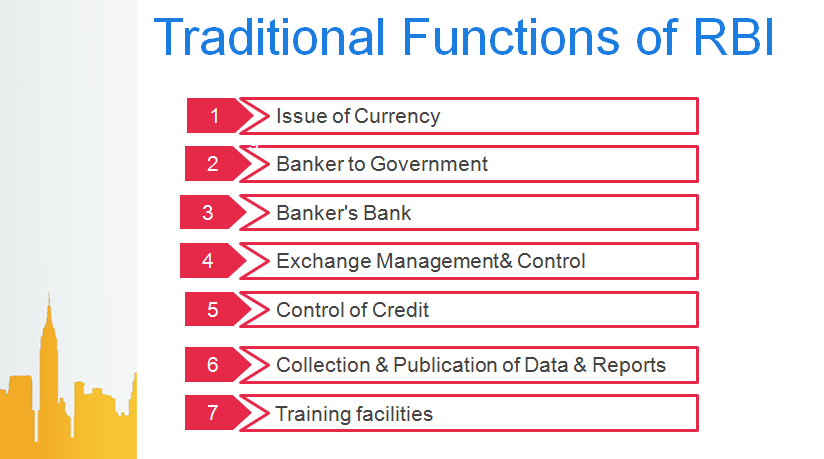Contents
Traditional Functions of RBI
The importance of RBI increased with the change of new technologies and global economic disruptions. During corona crisis, RBI played important role for the economical growth. The traditional functions of RBI tells us regarding RBI’s basic work. The RBI’s active role is required for the social and economical growth with the control of Inflationary trend.
The RBI play important role like traditional role, promotional role, Developmental role, proactive role in the Indian Economy. The Traditional functions of RBI are basic functions of any central Bank. Each country’s Central Bank ply the traditional role from the beginning of their origin.
The traditional functions of RBI are listed below,
- Issue of Currency
- Banker to Government
- Banker’s Bank
- Exchange Management& Control
- Control of Credit
- Collection & Publication of Data & Reports
- Training facilities

Traditional functions of RBI
Also Read Role of RBI in Control of Credit in India
Issue of Currency
The circulation and issuance of Currency done by Reserve Bank of India. The RBI Act As currency authority in India. The change in domination of currency also done by Reserve Bank of India. The RBI circulate currency of Rs 5, 10, 20, 100, 200, 500 and Rs 2000.
Banker to Government
RBI act as a banker to central and state government in India. It distributes money between the Governments. RBI Maintains and operates the cash and Debt balances of the central & state Governments. It Receives and makes payments on behalf of the Central& State Governments.
Banker’s Bank
RBI works as a bank between other commercial (scheduled) banks in India. The RBI ply role of clearing house for settlements of payments between the Bank’s. The clearing houses are managed by State Bank of India, it’s associate Bank, RBI and nationalized Banks.
The commercial bank can ask for emergency cash from the RBI, which delivered from the currency chest. The operation done with the help of Reserve bank of India.
Exchange Management & Control
The Reserve Bank of India Manages Foreign exchange reserves and Control external value of rupee in India. The value of rupee controlled by Reserve Bank of India by use of monetary policies and forex reserves. The Reserve Bank of India regulate the forex exchange in India.
Control of Credit
The control of credit is one tool of monetary policy. The Control of money supply and credit to ensure price stability in our country. Also the credit control used to control unemployment and inflationary trend in our country. The Reserve Bank of India use quantitative and qualitative method to control credit flow in econmy.
Collection & Publication of Data & Reports
The Reserve Bank of India publishes weekly, monthly, Quarterly, half yearly, yearly reports. The RBI publishes Weekly Statistical Supplement every week. The Statutory annual report are published by RBI which give us details for trends and direction of our economy.
The RBI also publishes report on forex reserves, Monetary statics, Statistics of Indian Economy, Financial and Banking Statistics, Report on Currency and Finance.
Training facilities
The RBI use Training facilities for the human capital and skill development of it’s employees. The Reserve Bank of India has two training collages in India. Also they operate four zonal training centers.
The Reserve Bank of India set up autonomous institutions like National Institute of Bank Management (NIBM), Pune; Indira Gandhi Institute for Development Research, Mumbai; and the Institute for Development
and Research in Banking Technology (IDRBT), Hyderabad.
Conclusion
The Traditional functions of RBI includes most important work of central Bank. The RBI use training facilities to train their employees. The monetary policies framed, implemented and tracked by Reserve Bank of India. The RBI work as Banker’s Bank and Banker for Government and state Governments.